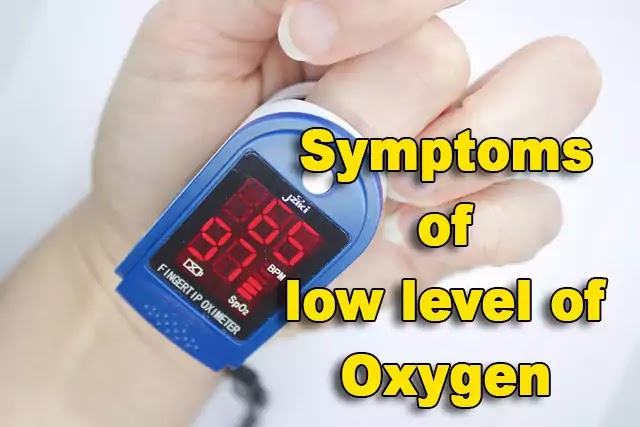Oxygen is one of the important gas and body components required by every cell to function properly. Without oxygen, you can’t survive for a longer period. In this covid-19 pandemic situation, we commonly heard that many positive patients die without oxygen supply on time. Due to the increased number of COVID-19 cases and severe forms of the disease, many states of India are facing an oxygen crisis.
Oxygen saturation can be measured at home by a device named a pulse oximeter. A finger of your hand is kept in this clip-like device and within few seconds it measures oxygen level and heart rate which is marked as Spo2 and PRbpm respectively. I have written a detailed article on the pulse oximeter. In this article, we will try to know about the symptoms a person may experience due to a low level of oxygen in the blood.
Moderate to severe cases of covid-19 may have a drop in oxygen saturation at any time especially the second week of illness is very crucial for them. If oxygen level or Spo2 is maintained between 94 to 100%, then there is no problem and follow all instructions and treatment advised by your doctor.
If Spo2 falls below 94%, the covid-19 patient should be alert and report to your doctor. He will advise you on what to do according to your disease condition. If Spo2 falls below 90%, covid-19 positive patients should be immediately admitted to a hospital where proper oxygen supply and ICU care are available to prevent more critical illness.
Table of Contents
What are symptoms of low oxygen levels in the body?
If COVID-19 patients have a drop-down in blood oxygen saturation or Spo2 in pulse oximeter especially below 90%, they feel or experience one or more following symptoms.
- When the oxygen level is critically low in the body the face becomes pale and lips, fingernails, and skin turns bluish in color. This sign is also called cyanosis. Naturally, our lips, fingers nails, and conjunctiva are pinkish in color and our face skin glows at a healthy maintained oxygen level.
- Sudden fall in oxygen level may also be presented as chest pain, tightness in the chest, and uneasy feeling.
- Continuous coughing is also a symptom if Spo2 is down from normal level. triggering of coughing indicates that you need more oxygen.
- Severe headache is also a symptom of very low oxygen saturation. The brain needs enough oxygen to work properly. In lack of oxygen, there is severe pain in the head.
- Difficulty in breathing or needs to take a deep breath also indicates your oxygen level is dropping. Your respiratory system needs to work hard to meet the demand for oxygen for your body.
If anyone is COVID-19 positive and these kinds of symptoms appear, they should immediately consult a doctor and should be admitted to the hospital for further care.
What should you do at home when your oxygen level is reducing?
You should continuously monitor your oxygen level by pulse oximeter device on an hourly basis. When it is reducing rapidly admit to the hospital for further treatment.
Until your relatives do arrangements for hospital admission, you should do proning exercise at home. For that, you should lie down in a prone position or on the abdomen for 30 to 60 minutes. After that change the position to the right or left side for a further 30 to 60 minutes. In between sit up at a 30 to 60-degree angle for 30 to 60 minutes. During a change of position, you should monitor the Spo2 level in the pulse oximeter device. You should avoid a prone position if it is contraindicated.
Be physically and mentally calm. Don’t provide much physical stress to your body. Stay away from anxiety, stress, and unnecessary worries. Otherwise, oxygen demand may be increased by your body.
What are contraindications for prone position during the low level of oxygen?
Here are absolute contraindications for the prone position in which you should avoid proning for self ventilation.
- If the patient has an immediate need for intubation.
- If the patient has respiratory distress and for that accessory muscles are active. If the respiratory rate is more than 35 and the PCO2 level is more than 6.5 mmol per liter.
- If the patient is reducing consciousness level.
- In case of spinal fracture, severe facial fracture, or other non-fixated fractures proning should be avoided.
- If the patient has done any recent abdominal surgery, suffered from ischemia of the intestine, or has raised intraabdominal pressure from any diseased condition.
- If the patient is cardiovascularly unstable, recent placement of a pacemaker or ICD insertion, or recently suffered from thromboembolism.
Here are relative contraindications for proning.
- The second and third trimester of pregnancy
- If the patient is severely obese
- If there is any facial injury
- If the patient is suffering from raised intracranial pressure and epilepsy
FAQs
Can prolonged use of medical masks cause CO2 intoxication and oxygen deficiency?
The medical mask also called a surgical mask is flat, pleated, and usually three-layered. It is fixed to cover the nose and mouth via a head flexible bandage or have ear loops.
There are many rumors spreading in social media stating that prolonged use of medical masks can cause CO2 intoxication and oxygen deficiency in your body. But it is not true. A medical or surgical mask when used for a long time can cause an uncomfortable feeling for you, but it doesn’t cause CO2 intoxication nor oxygen deficiency in your body. So stay away from this kind of rumor.
Also read:
Is it safe to drink sugarcane juice for a covid positive patient?
7 Health tips to be safe in the second wave of covid-19
6 Immunity weakening food categories to be avoided in covid pandemic

